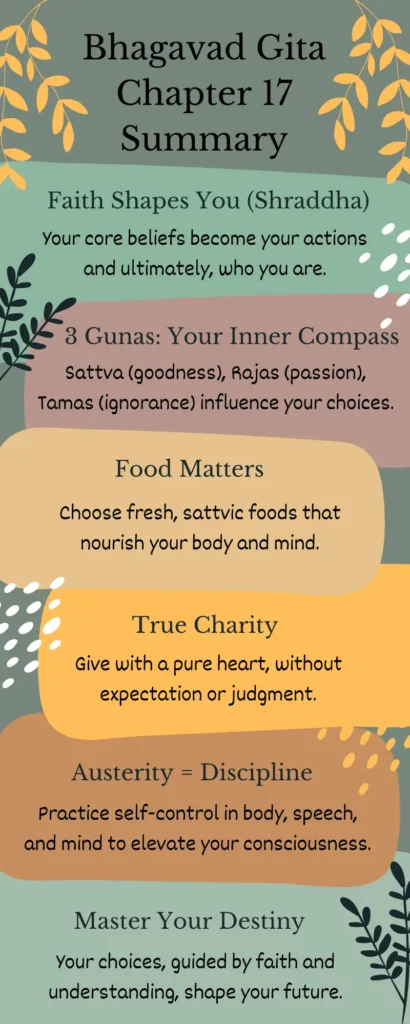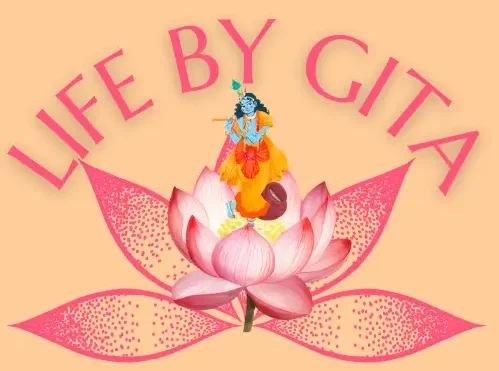
Welcome everyone! We’re back with another verse-dive into the Bhagavad Gita! Today, we are going to dive deep in the Bhagavad Gita Chapter 17 Summary. It is going to be a creator of your destiny as it explains the Faith and Destiny concept in the life.
1. Introduction
In the last chapter, we explored the divine and demonic qualities that reside within us all. Now, Chapter 17 of Bhagavad Gita titled, Yoga through Grasping the Three Divisions of Faith takes a fascinating turn, delving into the concept of Shraddha, which translates to faith. It’s about understanding how our inherent beliefs shape our actions and ultimately, our destiny.
This chapter is a treasure trove of wisdom, offering a framework to navigate life’s complexities. So, get ready to unpack the essence of Bhagavad Gita Chapter 17 summary!
2. Diving Deeper: The Three Gunas and Their Influence
The chapter opens with a powerful verse (17.3):
“A person is composed of his faith. What his faith is, he becomes that.“
Whoa, right? This verse emphasizes that our core beliefs become the driving force behind our actions and ultimately, shape who we are.

Krishna, the divine guide, then introduces the concept of Gunas – the three fundamental qualities that influence our perception and actions. We have already read the concept of Gunas in the Chapter 14. Chapter 17 provides the correlation with the actions performed by the human beings. Take a look:
- Sattva (goodness): Characterized by purity, knowledge, and serenity. Imagine a calm lake reflecting the sky – that’s the sattvic state.
- Rajas (passion): Marked by ambition, desire, and a drive for achievement. Think of a raging waterfall, powerful but potentially destructive.
- Tamas (ignorance): Defined by laziness, negativity, and inertia. Picture a stagnant swamp, devoid of life and movement.
3. A Guide for Daily Life: Classifying Our Actions
The chapter goes on to categorize our daily activities – food, sacrifice, austerity, and charity – based on the three Gunas.
For instance, a sattvic diet would involve fresh, healthy food, while a tamasic diet might involve overindulgence or unhealthy choices.
This classification system helps us understand the underlying motivations behind our actions. Are we acting out of a sense of duty and selflessness (sattvic), or are we driven by ego and a thirst for recognition (rajasic)?
This introspection is crucial in today’s fast-paced world. We’re constantly bombarded with external stimuli, making it easy to fall into tamasic patterns of mindless busyness. By understanding the Gunas, we can make conscious choices, aligning our actions with our higher self (sattva).
Here’s a breakdown of food, sacrifice, austerity, and charity based on the three Gunas in the Bhagavad Gita:
3.1 Sattva (Goodness)
- Food: Simple, vegetarian, fresh, and nourishing meals. Think fruits, vegetables, whole grains, and legumes.
- Sacrifice: Performed with a pure heart, without expecting anything in return. Offering prayers, helping others, or contributing to a good cause would be considered sattvic sacrifices.
- Austerity: Self-discipline practiced with a sense of calmness and detachment. This could involve regular meditation, studying scriptures, or simple living. (You will read later in this article just after the gunas, about how to master austerity of body, speech and mind)
- Charity: Giving without expectation of reward, motivated by a genuine desire to help others. Donating to those in need, volunteering your time, or offering selfless service are all examples of sattvic charity.
3.2 Rajas (Passion)
- Food: Spicy, stimulating, or overly rich foods. This could also include eating out of boredom or emotional triggers.
- Sacrifice: Performed with the desire for personal gain, fame, or recognition. Offering sacrifices to impress others or gain favors would fall under this category.
- Austerity: Practiced with a sense of competition, pride, or to show off one’s discipline. This could involve extreme fasting or physical exertion done to impress others.
- Charity: Giving with the expectation of something in return, or with a sense of superiority over the recipient. Donating for tax benefits or social recognition would be considered rajasic charity.
3.3 Tamas (Ignorance)
- Food: Overindulgence, stale or unhealthy foods, or anything consumed without mindfulness. Think processed foods, excessive meat consumption, or eating late at night.
- Sacrifice: Performed without proper understanding or with a negative intention. This could involve rituals done out of fear or superstition.
- Austerity: Self-torture or neglecting one’s basic needs in the name of discipline. This can have negative consequences on both physical and mental health.
- Charity: Giving out of obligation, guilt, or without any real thought or compassion for the recipient. This kind of charity lacks the genuine spirit of helping others.
4. Types of Austerity
In Bhagavad Gita Chapter 17, austerity (tapas) is presented in a multifaceted way, encompassing the body, speech, and mind. It’s not about self-torture, but about cultivating discipline and self-control to elevate your consciousness. Here’s a breakdown of each type of austerity:
4.1 Austerity of the Body (Sharirika Tapas)
- Focus: Actions and practices that promote physical and mental well-being.
- Examples:
- Simple living: Avoiding overindulgence in food, sleep, or possessions.
- Cleanliness: Maintaining physical hygiene and a clean environment.
- Celibacy: Practicing sexual restraint (interpreted differently by various schools of thought, some focusing on responsible marital life).
- Non-violence: Avoiding harming oneself or others physically or emotionally.
- Asana practice: Yoga postures that promote physical health and discipline.
4.2 Austerity of Speech (Vachika Tapas)
- Focus: Using words thoughtfully and constructively.
- Examples:
- Truthful speech: Speaking honestly and avoiding lies or exaggerations.
- Kind speech: Using words that are pleasant, encouraging, and avoid causing pain.
- Necessary speech: Avoiding idle chatter or gossip, speaking only when necessary.
- Beneficial speech: Using words that uplift, inspire, and offer knowledge.
- Silent contemplation: Engaging in periods of silence for introspection and meditation.
4.3 Austerity of the Mind (Manasika Tapas)
- Focus: Controlling the mind and its desires.
- Examples:
- Serenity: Maintaining calmness and composure amidst challenges.
- Gentleness: Cultivating kindness and compassion towards oneself and others.
- Self-control: Disciplining the mind to avoid negative thoughts and emotions.
- Purity of purpose: Focusing on noble goals and aligning actions with higher values.
- Detachment: Letting go of attachments to material possessions and outcomes.
By practicing these forms of austerity, you cultivate self-discipline, inner peace, and clarity of mind. This allows you to approach life’s challenges with a centered and focused awareness, ultimately leading to a higher spiritual state.

5. Conclusion: Faith as a Guiding Light
Bhagavad Gita Chapter 17 summary reminds us that faith is more than just blind belief. It’s a conscious decision to cultivate sattvic qualities and align ourselves with the divine. By understanding the Gunas and their influence, we can navigate life’s complexities with greater clarity and purpose. Remember, the Bhagavad Gita is a timeless guide, offering significant wisdom for navigating life’s challenges. This chapter on Shraddha is a powerful reminder that our faith shapes our destiny. So, choose your faith wisely, and let it illuminate your path!
If you have any comment and feedback, then feel free to leave it in the comment section at the bottom.
Read Also: Bhagavad Gita Chapter 12 Summary: The Power of Devotion (Bhakti Yoga)
If you want to read the above summary offline then, you can download its pdf version below:
Bhagavad Gita Chapter 17 Summary pdf
6. FAQs
Q1. What is the significance of Shraddha in the Bhagavad Gita?
A. Shraddha is the foundation of our spiritual journey. It represents our inherent faith and the lens through which we perceive the world.
Q2. How can we cultivate Sattva in our daily lives?
A. Practicing mindfulness, adopting a healthy lifestyle, and engaging in selfless service are all ways to cultivate Sattva.
Further Reading
Holy Bhagavad Gita

